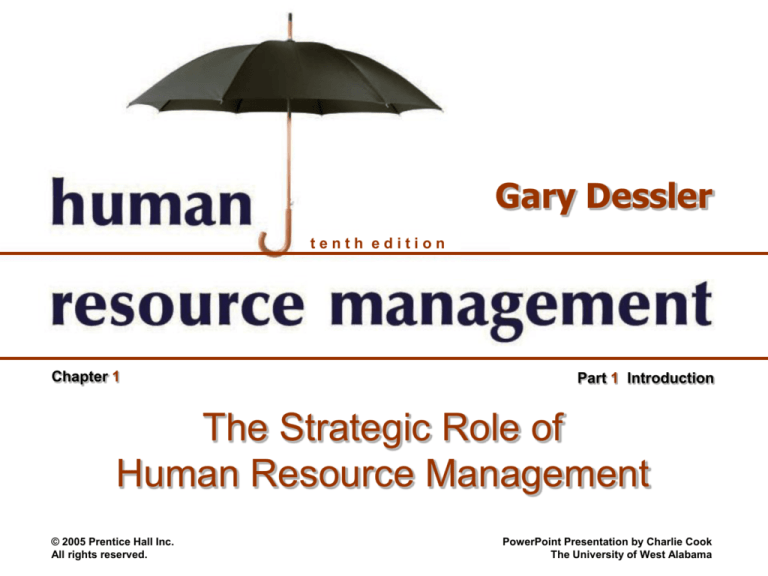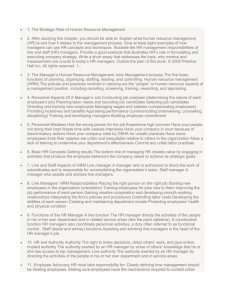
Gary Dessler
tenth edition
Chapter 1
Part 1 Introduction
The Strategic Role of
Human Resource Management
© 2005 Prentice Hall Inc.
All rights reserved.
PowerPoint Presentation by Charlie Cook
The University of West Alabama
The Changing Environment Of
HR Management
HR’s changing role:
“ Personnel departments”
– Took over hiring and firing from supervisors,
payroll, and benefit plans administration.
– In the 1930s added “protecting the firm in its
interaction with unions” responsibilities (labor
relations).
– Assumed organizational responsibilities for equal
employment and affirmative action.
© 2005 Prentice Hall Inc. All rights reserved.
1–2
A Changing HR Environment
Globalization
Technological Advances
Exporting Jobs
The Nature of Work
Workforce Demographics
© 2005 Prentice Hall Inc. All rights reserved.
1–3
Employment Exodus:
Projected Loss of Jobs and Wages
Source: Michael Shroeder, “States Fight Exodus of Jobs,” Wall Street Journal, June 3, 2003, p. 84.
© 2005 Prentice Hall Inc. All rights reserved.
Figure 1–4
1–4
Measuring HR’s Contribution
Strategy
– The company’s long-term plan for how it will
balance its internal strengths and weaknesses with
its external opportunities and threats to maintain a
competitive advantage.
• HR managers today are more involved in partnering with
their top managers in both designing and implementing
their companies’ strategies.
– Top management wants to see, precisely, how the
HR manager’s plans will make the company more
valuable.
© 2005 Prentice Hall Inc. All rights reserved.
1–5
HR Metrics
Absence Rate
[(Number of days absent in month) ÷ (Average number of
employees during mo.) × (number of workdays)] × 100
Cost per Hire
(Advertising + Agency Fees + Employee Referrals + Travel cost
of applicants and staff + Relocation costs + Recruiter pay
and benefits) ÷ Number of Hires
Health Care Costs per Employee
Total cost of health care ÷ Total Employees
HR Expense Factor
HR expense ÷ Total operating expense
Sources: Robert Grossman, “Measuring Up,” HR Magazine, January 2000, pp. 29–35; Peter V. Le Blanc, Paul Mulvey, and Jude T.
Rich, “Improving the Return on Human Capital: New Metrics,” Compensation and Benefits Review, January/February 2000, pp. 13–
20;Thomas E. Murphy and Sourushe Zandvakili, “Data and Metrics-Driven Approach to Human Resource Practices: Using Customers,
Employees, and Financial Metrics,” Human Resource Management 39, no. 1 (Spring 2000), pp. 93–105; [HR Planning, Commerce
Clearing House Incorporated, July 17, 1996;] SHRM/EMA 2000 Cost Per Hire and Staffing Metrics Survey; www.shrm.org.
© 2005 Prentice Hall Inc. All rights reserved.
Figure 1–5
1–6
HR Metrics (cont’d)
Human Capital ROI
Revenue − (Operating Expense − [Compensation cost +
Benefit cost]) ÷ (Compensation cost + Benefit cost)
Human Capital Value Added
Revenue − (Operating Expense − ([Compensation cost +
Benefit Cost]) ÷ Total Number of FTE
Revenue Factor
Revenue ÷ Total Number of FTE
Time to fill
Total days elapsed to fill requisitions ÷ Number hired
Sources: Robert Grossman, “Measuring Up,” HR Magazine, January 2000, pp. 29–35; Peter V. Le Blanc, Paul Mulvey,
and Jude T. Rich, “Improving the Return on Human Capital: New Metrics,” Compensation and Benefits Review,
January/February 2000, pp. 13–20;Thomas E. Murphy and Sourushe Zandvakili, “Data and Metrics-Driven Approach to
Human Resource Practices: Using Customers, Employees, and Financial Metrics,” Human Resource Management 39,
no. 1 (Spring 2000), pp. 93–105; [HR Planning, Commerce Clearing House Incorporated, July 17, 1996;] SHRM/EMA
2000 Cost Per Hire and Staffing Metrics Survey; www.shrm.org.
© 2005 Prentice Hall Inc. All rights reserved.
Figure 1–5 (cont’d)
1–7
HR Metrics (cont’d)
Training Investment Factor
Total training cost ÷ Headcount
Turnover Costs
Cost to terminate + Cost per hire + Vacancy Cost + Learning
curve loss
Turnover Rate
[Number of separations during month ÷ Average number of
employees during month] × 100
Workers’ Compensation Cost per Employee
Total WC cost for Year ÷ Average number of employees
Sources: Robert Grossman, “Measuring Up,” HR Magazine, January 2000, pp. 29–35; Peter V. Le Blanc, Paul Mulvey,
and Jude T. Rich, “Improving the Return on Human Capital: New Metrics,” Compensation and Benefits Review,
January/February 2000, pp. 13–20;Thomas E. Murphy and Sourushe Zandvakili, “Data and Metrics-Driven Approach to
Human Resource Practices: Using Customers, Employees, and Financial Metrics,” Human Resource Management 39,
no. 1 (Spring 2000), pp. 93–105; [HR Planning, Commerce Clearing House Incorporated, July 17, 1996;] SHRM/EMA
2000 Cost Per Hire and Staffing Metrics Survey; www.shrm.org.
© 2005 Prentice Hall Inc. All rights reserved.
Figure 1–5 (cont’d)
1–8
Measuring HR’s Contribution
The HR Scorecard
– Shows the quantitative standards,
or “metrics” the firm uses to
measure HR activities.
– Measures the employee behaviors
resulting from these activities.
– Measures the strategically relevant
organizational outcomes of those
employee behaviors.
© 2005 Prentice Hall Inc. All rights reserved.
1–9
Benefits of a High Performance Work
System (HPWS)
Generate more job applicants
Screen candidates more effectively
Provide more and better training
Link pay more explicitly to performance
Provide a safer work environment
Produce more qualified applicants per position
More employees are hired based on validated
selection tests
Provide more hours of training for new employees
Higher percentages of employees receiving regular
performance appraisals.
© 2005 Prentice Hall Inc. All rights reserved.
1–10
The New HR Manager
New Proficiencies
– HR proficiencies
– Business proficiencies
– Leadership proficiencies
– Learning proficiencies
© 2005 Prentice Hall Inc. All rights reserved.
1–11
The New HR Manager (cont’d)
The Need to “Know Your Employment Law”
– Equal employment laws
– Occupational safety and health laws
– Labor laws
© 2005 Prentice Hall Inc. All rights reserved.
1–12
Effects CFOs Believe Human Capital
Has on Business Outcomes
Source: Steven H. Bates, “Business Partners,” HR Magazine, September 2003, p. 49
© 2005 Prentice Hall Inc. All rights reserved.
Figure 1–6
1–13
The New HR Manager
Ethics and HR
– Ethical lapses (e.g., Enron, Martha Stewart)
Sarbanes-Oxley Act in 2003
– Intended to curb erroneous corporate financial
reporting:
• Requires CEOs and CFOs to certify their companies’
periodic financial reports.
• Prohibits personal loans to executive officers and
directors.
• Requires CEOs and CFOs to reimburse their firms for
bonuses and stock option profits if corporate financial
statements subsequently require restating.
© 2005 Prentice Hall Inc. All rights reserved.
1–14
HR Professional Certification
HR is becoming more professionalized.
Society for Human Resource
Management (SHRM)
– SHRM’s Human Resource Certification
Institute (HRCI)
• SPHR (senior professional in HR)
• PHR (professional in HR)
certificate
© 2005 Prentice Hall Inc. All rights reserved.
1–15
HR and Technology
Benefits of technological applications for HR
– Intranet-based employee portals through which
employees can self-service HR transactions.
– The availability of centralized call centers staffed
with HR specialists.
– Increased efficiency of HR operations.
– The development of data warehouses of HRrelated information.
– The ability to outsource HR activities to specialist
service providers.
© 2005 Prentice Hall Inc. All rights reserved.
1–16
The Plan of This Book: Basic Themes
HR management is the responsibility of every
manager—not just those in the HR department.
HR managers must always stand ready to defend
their plans and contributions in measurable terms.
An HR department’s performance is measured
relative to achieving the company’s strategic aims.
HR managers increasingly rely on IT to help support
the company’s strategic aims.
Virtually every HR-related decision managers make
has legal implications.
Globalization and diversity are important HR issues
today.
© 2005 Prentice Hall Inc. All rights reserved.
1–17
Strategy and the Basic HR Process
Figure 1–8
© 2005 Prentice Hall Inc. All rights reserved.
1–18
KEY TERMS
management process
employee advocacy
human resource
management (HRM)
globalization
authority
line manager
staff manager
line authority
implied authority
nontraditional workers
human capital
strategy
metrics
HR Scorecard
outsourcing
functional control
© 2005 Prentice Hall Inc. All rights reserved.
1–19








